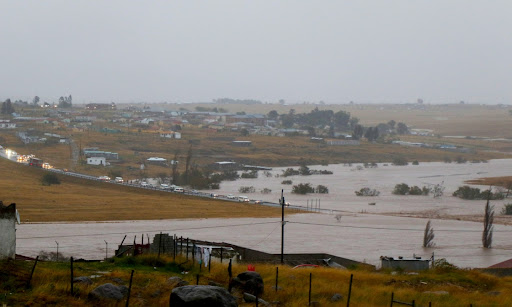A cold front sweeping across South Africa has unleashed havoc in parts of KwaZulu-Natal and the Eastern Cape. The severe weather conditions brought heavy snow, torrential rain, gale-force winds, and freezing temperatures, causing widespread disruption and chaos. Power outages, road closures, and a near-tragic incident involving schoolchildren have been reported as the region grapples with the aftermath of the storm.
The South African Weather Service forecaster Lehlogonolo Thobela highlighted the ongoing impact of the cut-off low weather system, emphasizing its potential effects on the eastern half and coastal areas of the Eastern Cape. The weather warnings, including an Orange Level 9 alert for disruptive rain, signal the severity of the situation. Thobela warned of potential flooding, urging the public to stay vigilant and prepared for further disruptions to essential services like water, electricity, and transportation.
In the Eastern Cape, incidents such as a scholar transport bus being swept away at Efata Bridge underscore the dangers posed by the extreme weather. While three pupils were rescued, the exact number of passengers on board remains uncertain, reflecting the chaotic nature of the situation. The region has witnessed road closures due to snow, flooding, and power outages, requiring swift action from disaster management teams and local authorities to restore normalcy.
KwaZulu-Natal has also faced significant challenges, with snow blanketing areas in various districts and leading to the closure of key routes like the N2 and N3 highways. Uprooted trees and strong winds have further complicated the situation, prompting disaster management teams to deploy resources to clear roads and restore power. The provincial government has issued warnings and advisories to residents, emphasizing the need for caution and safety measures during this tumultuous period.
The disruption caused by the storm has extended to the electricity supply, with Eskom reporting weather-related outages affecting around 300,000 customers in the Eastern Cape and KwaZulu-Natal. The utility company’s technical teams are working tirelessly to address the interruptions caused by the damaging weather conditions, which include gale-force winds, rain, and snow. Affected areas span several towns and cities, highlighting the widespread impact of the cold front.
As the region grapples with the aftermath of the storm, emergency services and disaster management teams are on high alert, monitoring the situation closely and providing assistance where needed. Residents are urged to exercise caution, especially when using heating devices, candles, or alternative sources of warmth. The collaborative efforts of various agencies and organizations aim to mitigate the effects of the cold front and ensure the safety and well-being of all residents in the affected areas.
The recent weather events serve as a reminder of the unpredictability and intensity of nature, prompting communities and authorities to enhance preparedness and response strategies for future emergencies. The resilience and swift actions taken during this crisis underscore the importance of coordination and communication in managing natural disasters and ensuring the protection of lives and infrastructure. As the cleanup and recovery efforts continue, the impacted regions are poised to emerge stronger and more resilient in the face of adversity.









Leave feedback about this